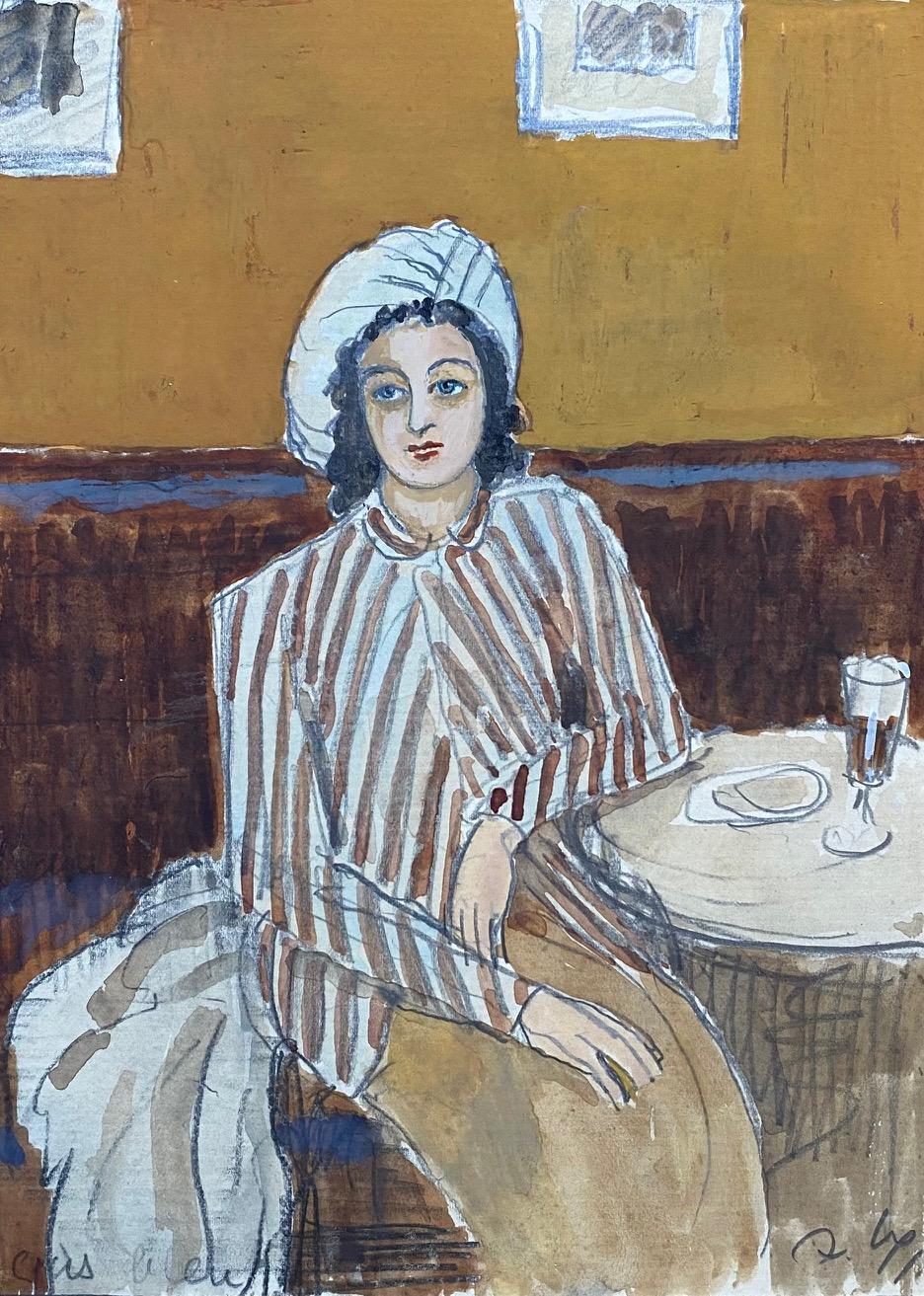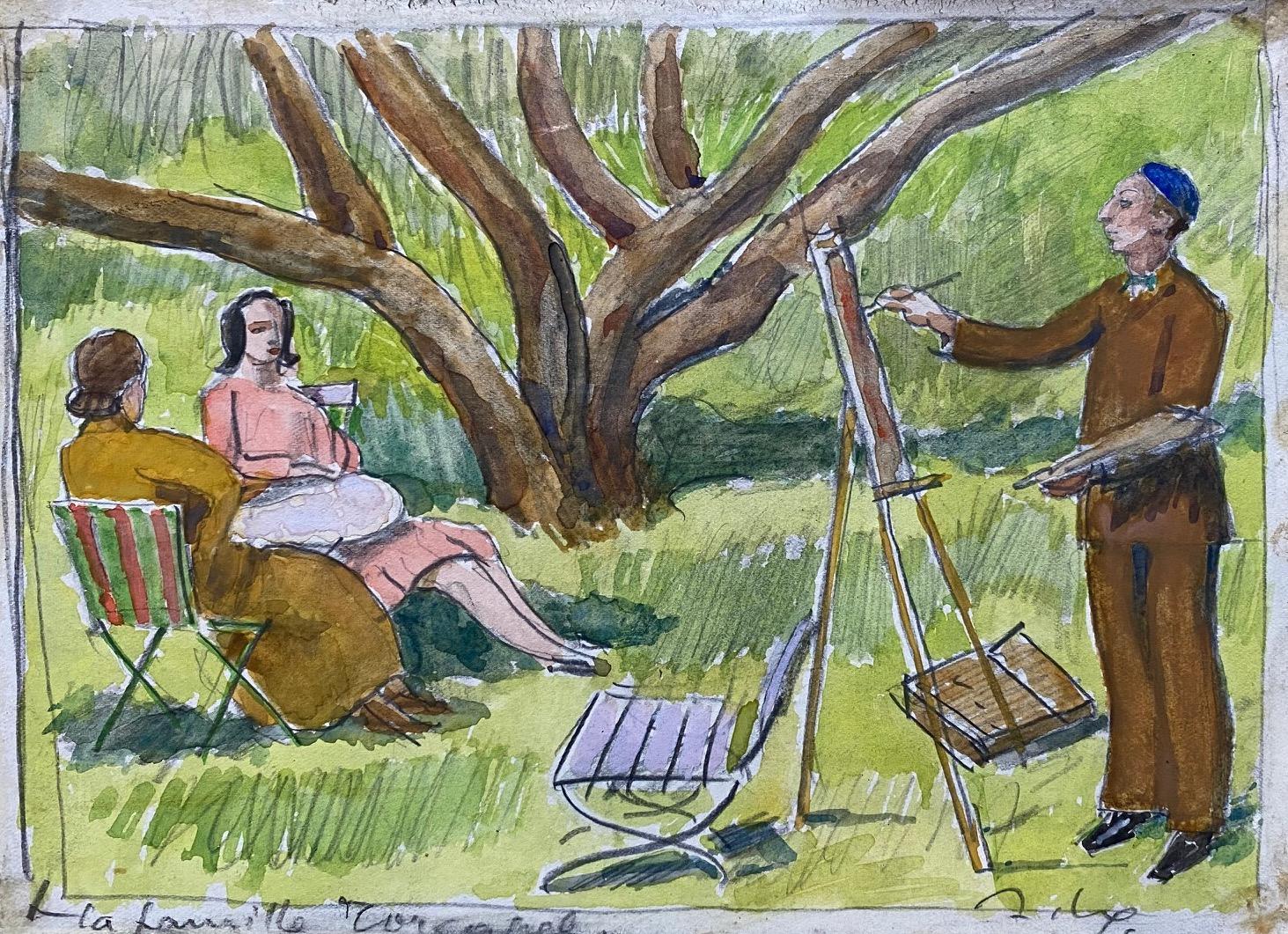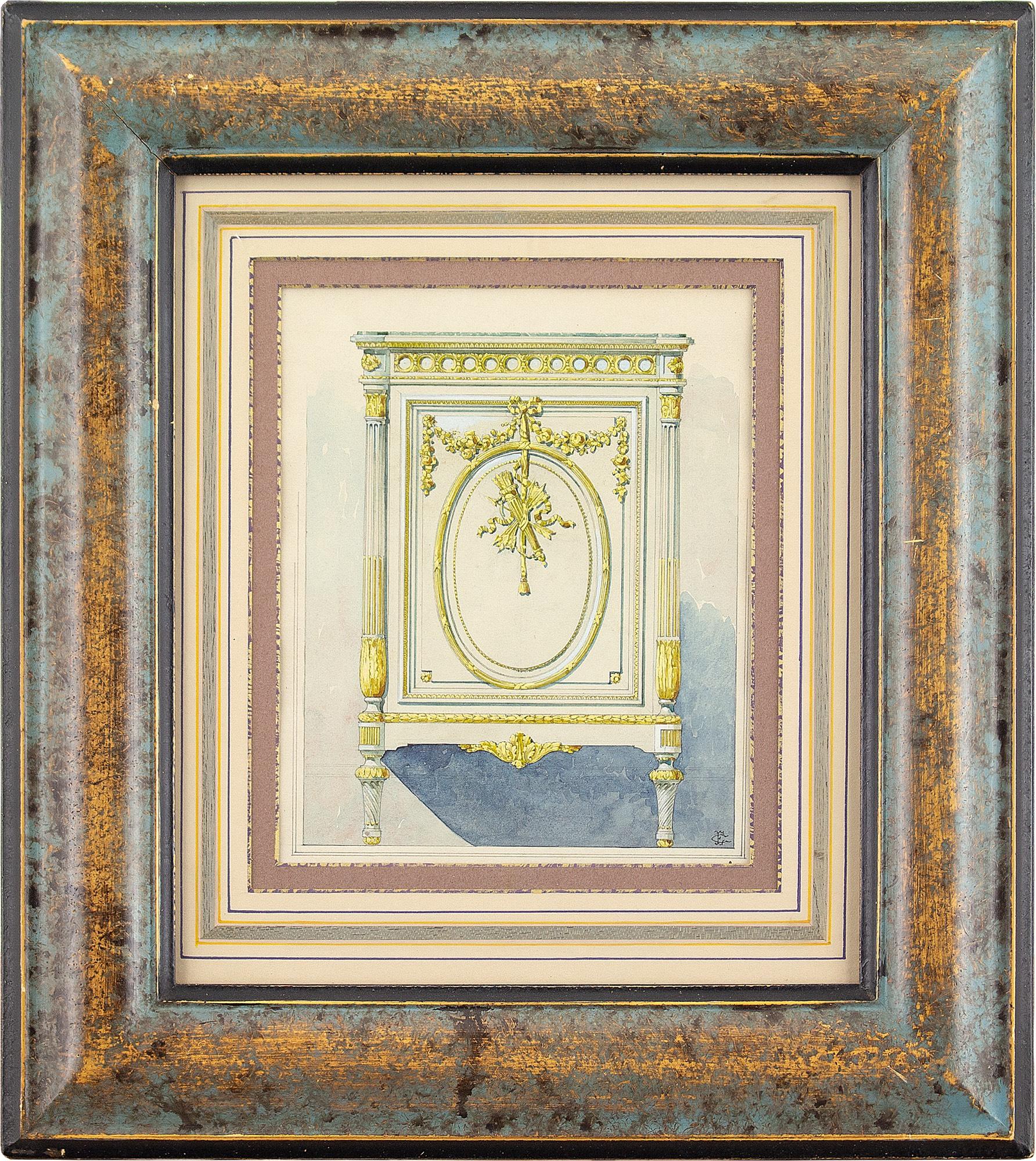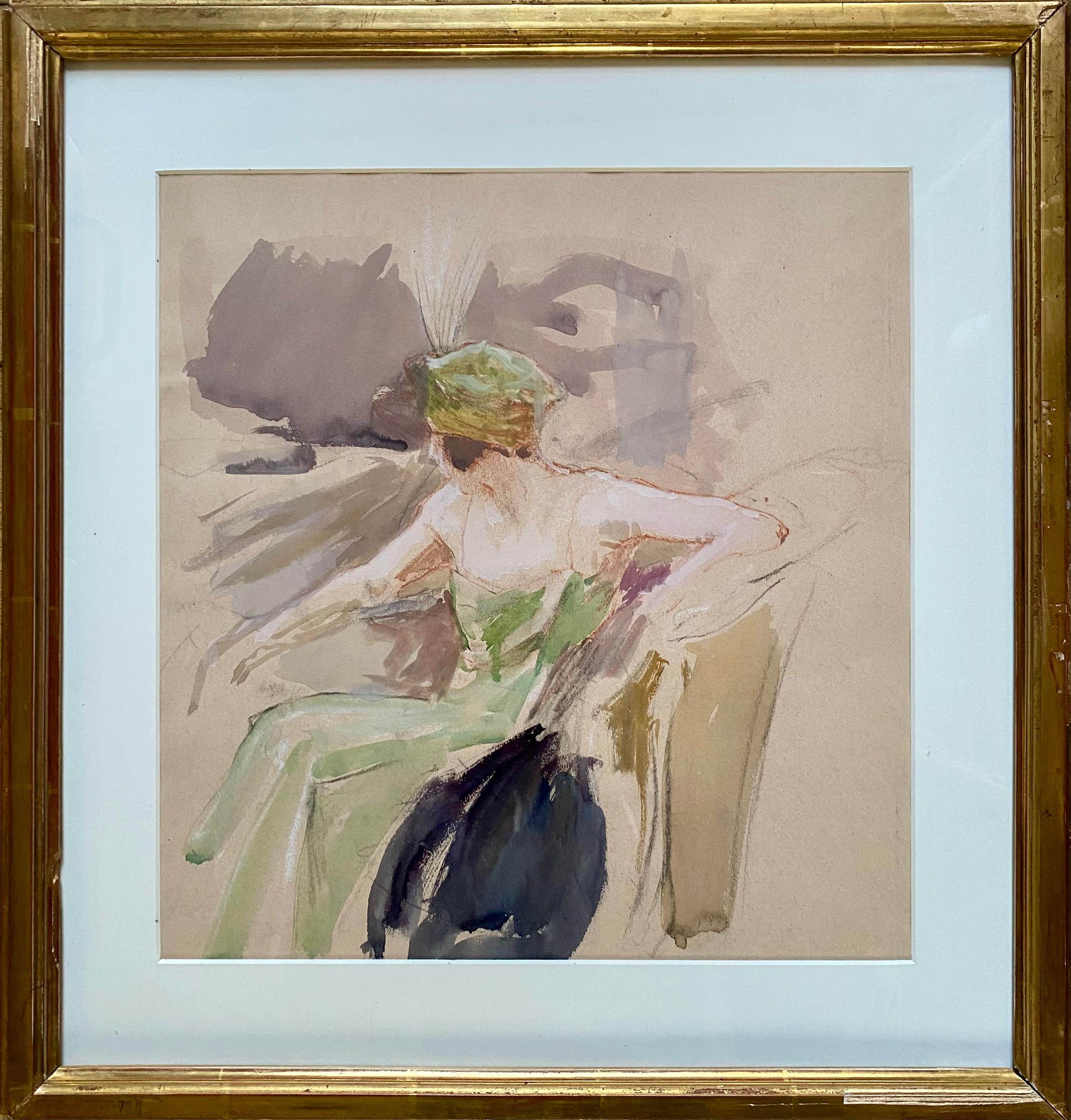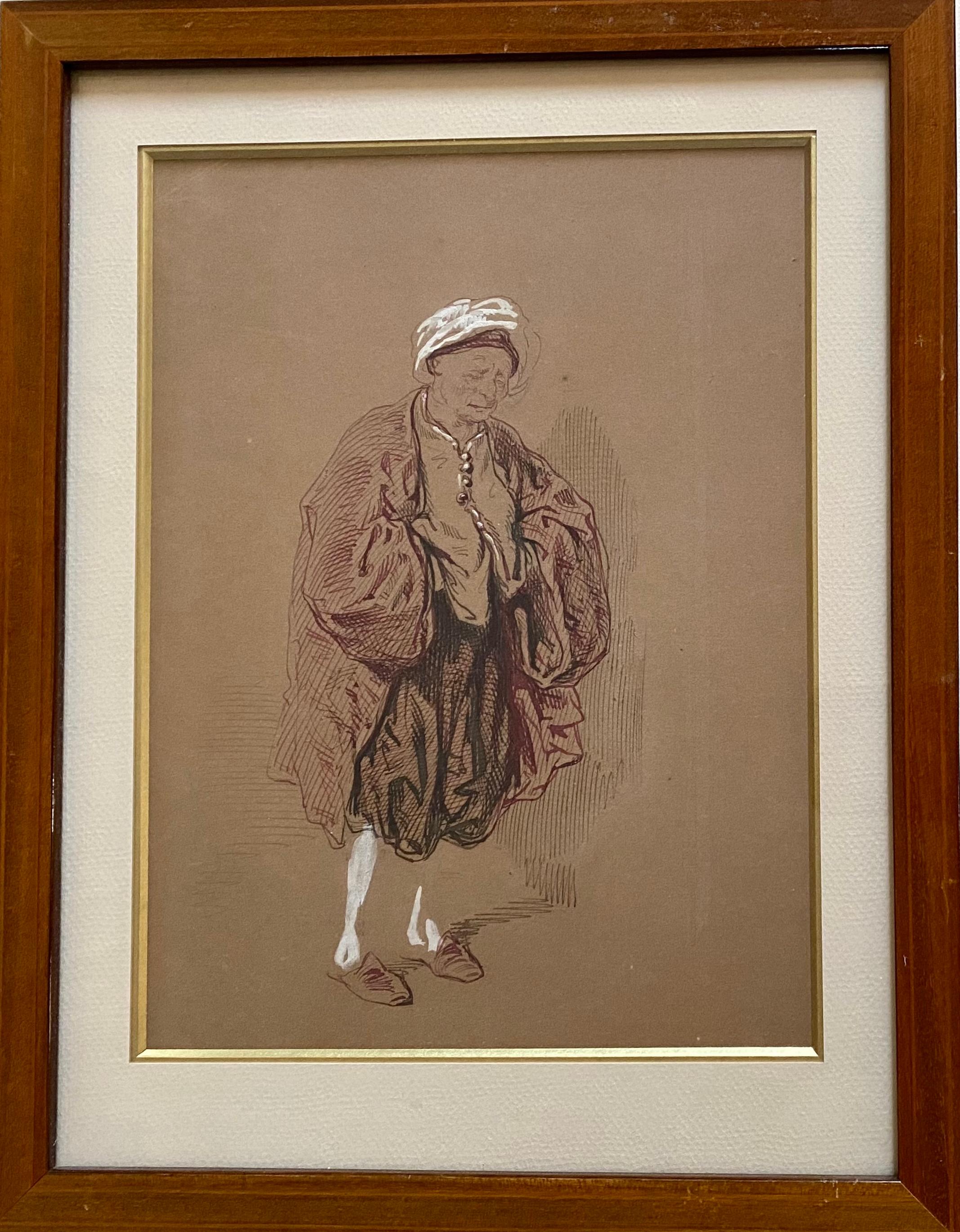Items Similar to Orientalist Portrait of an Arab Man, circa 1830s Jean-Horace Vernet (1789-1863)
Video Loading
Want more images or videos?
Request additional images or videos from the seller
1 of 11
Émile Jean-Horace VernetOrientalist Portrait of an Arab Man, circa 1830s Jean-Horace Vernet (1789-1863)Circa 1830s
Circa 1830s
About the Item
Orientalist Portrait of an Arab Man
Half-length, turned to the left, oval,
Jean-Horace Vernet (French 1789-1863)
Circa 1830s
Watercolor heightened with touches of white on paper
Signed with initials 'H.V.' lower left
Ex. collection Dr Simon Lee
9 1/2 x 7 (21 1/2 x 17 3/4 frame) inches
Horace Vernet was born in Paris in 1789 and was predestined for art by his family heritage of well-known and accomplished artists.
Vernet was France's foremost painter of land and seascapes, he was casually trained by his father, Carle Vernet, and his grandfather Joseph Vernet. A child prodigy, having become a professional by his teens he was spurred by financial needs to exploit his phenomenal natural gifts arising from his early marriage in 1811. A torrent of saleable work soon poured from his studio: fashion designs, caricatures, portraits, and landscapes.
In 1814 he was among the civilian defenders of Paris against the approaching allied nations, an episode he later represented in the painting "La Barrière de Clichy (1820, Louvre)."
In the early years of the Restoration, his studio became the meeting place of artists and veterans, filled with political intrigue, openly hostile to the Bourbon government. Much to that government's irritation, he flaunted his cult of Napoleon and found a patron in Louis-Philippe, duc d'Orléans, head of the disaffected cadet branch of the dynasty. A resolute modernist but little affected by romanticism, he befriended Gericault and was one of the Pioneers of lithography.
In a series of battle scenes from the Revolutionary and Napoleonic Wars, the battles of Jemmapes, Montmirail, Hanau, and Valmy were painted for the duc d'Orléans in 1821-1826 (National Gallery, London). Venet gave a foretaste of what was to become his specialty.
Paintings he created were seen to be rather conciliatory to the government, which were gratefully received. These pieces began producing positive and prompt results. In short order thereafter, he was made an officer of the Legion of Honor (1825), a member of the Institute (1826), and after successes at the Salons of 1826 and 1827 was appointed director of the French Academy in Rome (1829). During his seven years there, he displayed an agile versatility with paintings of Italian popular life (The Brigand's Confession), oriental subjects (The Arab Story-teller), and historical anecdotes (Encounter of Raphael and Michelangelo in the Vatican).
The Revolution in July 1830, which raised Louis-Philippe, Vernet's patron, to the throne, opened vast opportunities of official employment to him. The rapid flow of state commissions for battle pieces that now came his way taxed even his prodigious facility. Four very large canvases for the Galerie des Batailles at Versailles, shown at the Salon of 1836, were followed by a second series in 1841. Accepting his calling as that of a painter of modern national subjects, specifically of scenes of combat, Vernet conceived of his work as a form of eyewitness reportage that required observation at the actual theaters of war. In five long visits to North Africa (1833, 1837, 1839-1840, 1845, 1853), he gathered on-the-spot documentation of the French conquests in Algiers and Morocco, material that he later worked up into wall-size canvases destined for Versailles. Louis-Philippe's overthrow by the Revolution of 1848 and the advent of Napoleon III in 1849 scarcely affected his activity. The year 1850 found him at the French siege of Rome; in 1854 he visited the battlefields of the Crimea. He had in the meantime enjoyed the lucrative patronage of Czar Nicholas I during two long visits to Russia in 1836 and 1842-1843.
The Universal Exposition of 1855, at which he was represented by twenty-four paintings, crowned his popular and official success. His reputation among artists and critics, on the other hand, was not uncontested. Baudelaire scathingly referred to him as "un militaire qui fait de la peinture," and while his painstaking factuality and the sheer magnitude of his production commanded respect, the prosy shallowness of his realism, his stylistic banality, and the stridency of his chauvinism were early noted and contributed to the eventual neglect of his work.
At the time of his death in 1863, Vernet, a member of thirty academies, was nevertheless France's most famous artist, admired and imitated throughout Europe and deeply embedded in popular culture.
Public collections include briefly;
Rijksmuseum, MFA Houston, Krakow, LACMA, Cleveland, Met, British, Getty, Baltimore, etc...
- Creator:Émile Jean-Horace Vernet (1789 - 1863)
- Creation Year:Circa 1830s
- Dimensions:Height: 21.5 in (54.61 cm)Width: 17.75 in (45.09 cm)
- Medium:
- Movement & Style:
- Period:
- Condition:The painting has been recently reframed. The central image is in excellent condition.
- Gallery Location:SANTA FE, NM
- Reference Number:1stDibs: LU1408211298172
About the Seller
5.0
Platinum Seller
These expertly vetted sellers are 1stDibs' most experienced sellers and are rated highest by our customers.
Established in 1995
1stDibs seller since 2020
90 sales on 1stDibs
Typical response time: 1 hour
- ShippingRetrieving quote...Ships From: Santa Fe, NM
- Return PolicyA return for this item may be initiated within 2 days of delivery.
More From This SellerView All
- Drawing of Putti with Anchor by Jean-Jacques le Barbier l'Ainé (1738-1826)By Jean Jacques Francois Le BarbierLocated in SANTA FE, NMDrawing of Putti with Anchor Jean-Jacques le Barbier l'Ainé (1738-1826) Black pencil on paper Signed and dated lower left "...1822. 12 years l waiting" Considering that the anchor ...Category
1820s Academic Figurative Drawings and Watercolors
MaterialsPaper, Pencil
- Drawing of Putti in the Clouds by Jean-Jacques le Barbier l'Ainé (1738-1826)By Jean Jacques Francois Le BarbierLocated in SANTA FE, NMDrawing of Putti in the Clouds Jean-Jacques le Barbier l'Ainé (France, 1738-1826) Black pencil on paper Signed and dated lower left "Le Barbier L'ainé 1816" 10 1/4 x 12 1/4 inches ...Category
1810s Academic Figurative Drawings and Watercolors
MaterialsPencil, Paper
- Antique Dog Portrait "A Fine Gourmet!" 1855 by Louis Godefroy Jadin (1805-1882)Located in SANTA FE, NMAntique Dog Portrait "A Fine Gourmet!" Louis Godefroy Jadin (1805-1882) Oil on wood panel Signed and dated "1855" 18 x 14 frame size inches Louis God...Category
1850s French School Animal Paintings
MaterialsWood, Oil
- Pointillist Painting "The Road Beneath the Snow" Eugène Bégarat (French, 1943)By Eugène BégaratLocated in SANTA FE, NMPointillist Painting "The Road Beneath the Snow (Le Chemin Sous la Neige)" Eugène Bégarat (French, 1943) Oil on canvas 15 3/4 x 31 1/2 inches Saturated with winter's light glinting...Category
20th Century French School Landscape Paintings
MaterialsOil, Canvas
- Antique Portrait of 6 Dogs on Porcelain by Maison Pichenot-Loebnitz ca. 1870sLocated in SANTA FE, NMAntique and exceptionally rare and fine Portrait of 6 Dogs on Enameled Ceramic Maison Pichenot-Loebnitz France, ca. 1870. 25 x 8 (31 x 13 framed) inches This rectangular panel made of enameled ceramic was made by Jules Loebnitz in the second half of the 19th century depicts a suite of 6 very fine canines in a landscape setting. The Pichenot-Loebnitz factory was founded by Mr Pichenot, grandfather of Jules Loebnitz, in 1833. From 1841, Mr Pichenot created a new, innovative method of uncrackable earthenware panels for architectural mantels, winning a medal at the Exhibition of 1844. In 1857, Jules Loebnitz, an artist as much as an industrialist, became director of the factory. For his first major job, Loebnitz passionately collaborated with architect Félix Duban on the restoration of the Blois Castle, recreating the antique tiles of the mantelpieces. He then went to work with the most prominent architects of his times; Eugène Viollet-le-Duc, Laval, Charles Garnier, Just Lisch and Paul Sédille. A friendship was born in 1867 between Paul Sédille, the architect of the Printemps department stores and the Basilica of Bois-Chenu in Domrémy-la-Pucelle, and Jules Loebnitz that would lead to a tight, long-lasting professional, artistic, and intellectual collaboration. This was an important meeting between the theorist of polychrome architecture and the man who had pushed French ceramic art considerably forward, allowing for large, enameled earthenware plates decorated with very bright and long-lasting glass-like colors. Many architectural projects were born from the collaboration of Sédille and Loebnitz: World’s fair pavilions, apartment buildings, villas, hotels, and monuments. During the Great Exhibition of 1878, Paul Sédille created the door of the Palais des Beaux-arts, while Jules Loebnitz was in charge of the ceramic decoration of the facade. A reporter covering the 1878 World’s fair described the monumental door...Category
1870s French School Animal Paintings
MaterialsEnamel
- "Study of a Frog Studying Various Plants" France, Early 19th centuryLocated in SANTA FE, NM"Study of a Frog Studying Various Plants" France, 19th century OIl on paper Signed 14 x 10 (18 x 14 frame) inches This well-painted composition of a frog which seems to be observin...Category
Mid-19th Century French School Animal Paintings
MaterialsPaper, Oil
You May Also Like
- At the bar att. to Alexandre Blanchet - Drawing 23x29 cmBy Alexandre BlanchetLocated in Geneva, CHWatercolor on cardboard without frameCategory
Early 20th Century French School Portrait Drawings and Watercolors
MaterialsWatercolor, Carbon Pencil
- Torcapel Family att. to Alexandre Blanchet - Drawing 14x20 cmBy Alexandre BlanchetLocated in Geneva, CHWatercolor on paper without frameCategory
Early 20th Century French School Portrait Drawings and Watercolors
MaterialsWatercolor, Carbon Pencil
- The Introduction, French School, 18th centuryLocated in Middletown, NYIn this charming scene a maid appears bashful as she is introduced by her mother to the shepherd’s son. Ink and wash on hand made, cool-toned cream laid paper, 6 3/4 x 8 7/8 inches...Category
Mid-18th Century French School Figurative Drawings and Watercolors
MaterialsInk, Watercolor, Handmade Paper, Laid Paper
- 19th-Century French School, Two Designs For Rococo-Revival FurnitureLocated in Cheltenham, GBThis decorative pair of late 19th-century French drawings depict a daybed and commode in the Rococo taste. Drawings of this nature were vital for furniture makers and those working ...Category
Early 20th Century French School Portrait Drawings and Watercolors
MaterialsGouache, Paper, Watercolor
- Study Of Seated WomanLocated in PARIS, FRHenri ROYER Nancy 1869 - 1938 Paris Study of Seated Woman Watercolor, gouache and charcoal on beige paper Circa 1900-1910 Unsigned 34 x 31 cm sheet 48 x 45 cm frame Provenance: Esta...Category
Early 20th Century French School Portrait Drawings and Watercolors
MaterialsCharcoal, Watercolor, Gouache
- The Hypochondriac: French 19th Century Theatre Comedy drawingBy Paul Gavarni (Guillaume Sulpice Chevalier)Located in Norwich, GBA magnificent and sensitively treated line drawing in coloured ink, heightened with white. It depicts Argan, the hypochondriac from Molière's play of the same name. Dating from circa...Category
Mid-19th Century French School Figurative Drawings and Watercolors
MaterialsInk, Paper, Gouache
